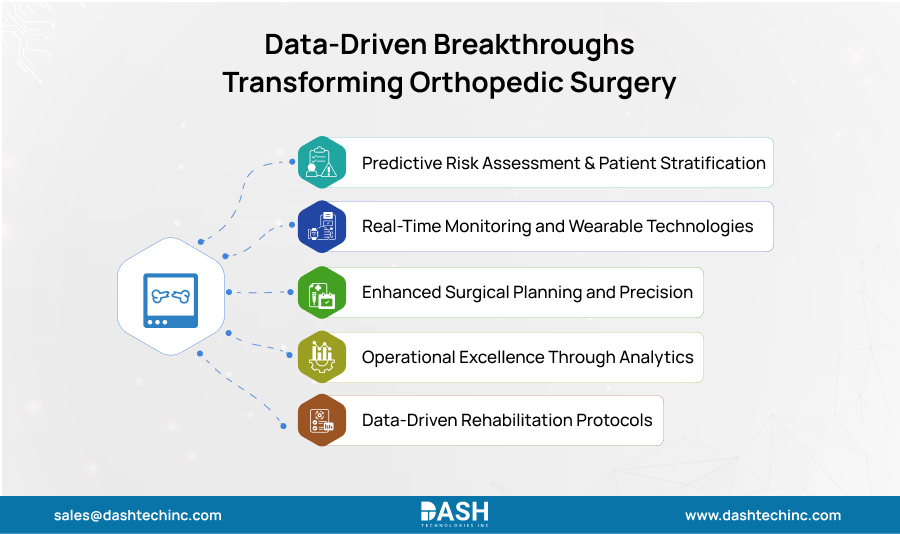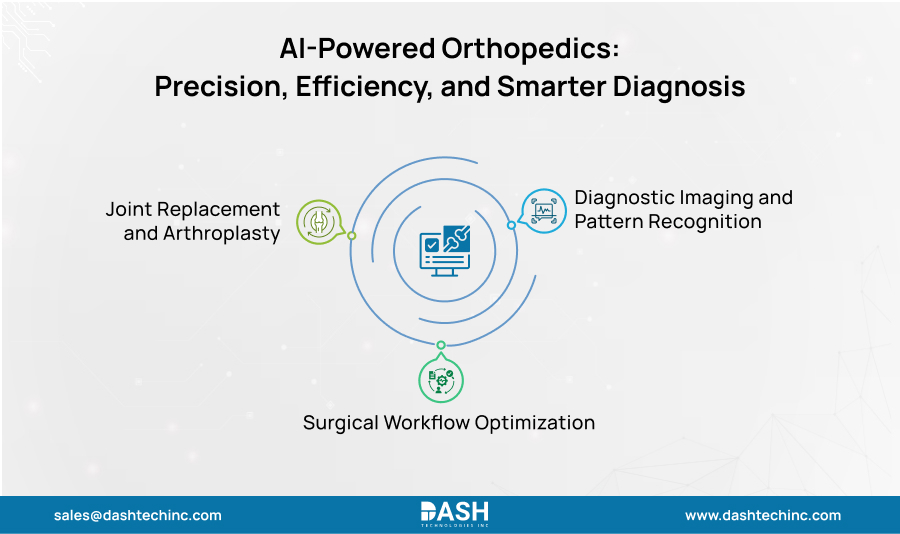Benefits of Data Analytics in Orthopedic Surgery
The digital revolution that is storming healthcare is breaking into the OR & beyond, with data analytics in orthopedic surgery becoming an integral part of modern practice. Orthopedic Surgery has been traditionally guided by a surgeon’s dexterity, expertise, and procedural protocols that have been curated over decades. While the importance of these elements will always remain, the field is poised to be propelled by a novel force: Data.
This evolution isn’t just about digitizing records; artificial intelligence (AI) in orthopedics is starting to enhance the operating room and entire patient journeys from diagnosis, surgery, to post-operative care through data and analytics. AI, machine learning, and the digitization of the care journey are already beginning to help surgeons make informed decisions and to create more personalized care journeys, and significantly improve patient outcomes.
The Digital Transformation of Orthopedics
The orthopedic profession is changing, moving away from the use of historical research towards future data-driven decision-making. In the past, the growth of surgical methods relied on long-term, in-depth research and historical information. Today, with the integration of new technologies, there is a stream of ongoing information, and medical personnel can respond and hone their methods according to changing situations. Collection, analysis, and application of data in Orthopedics to affect the outcome and thus change the decision-making process.
Advanced monitoring tech, along with patient-reported outcomes, integrating them with EHRs, creates a great comprehensive data ecosystem. This arrangement helps healthcare providers to predict health complications, identify different sorts of patterns, & optimize the treatment based on actual evidence rather than intuition alone.
Orthopedic practice now has several resources, such as physical exam data, medical history, imaging data, laboratory test values, & demographic information to use in customizing treatments to each patient. Physicians can now get a more complete picture of their patients’ health & can judge each patient’s individual risk factors & tailor interventions accordingly & proactively.
How Data Analytics in Orthopedic Surgery Transforms Outcomes

Predictive Risk Assessment & Patient Stratification
Machine learning in orthopedic surgery enables sophisticated risk prediction by analyzing large patient history databases, imaging reports, and surgical histories. Such algorithms could identify patterns & correlations between factors like patient age, comorbidities, and previous surgeries and potential outcomes of surgery with high accuracy.
In case of polytrauma, the AI systems help sort through injuries, decide which treatments are most important, and predict problems before they happen. Predictive models look at the risks of infection and implant failure in knee and hip replacement surgeries. This lets surgeons change their plans of time. The predictive capacity is also noted in fracture management. AI in orthopedics assesses the risk of healing or improper bone alignment to help doctors make better treatment decisions.
Real-Time Monitoring and Wearable Technologies
Orthopedic MedTech innovations have introduced sophisticated monitoring devices which enable uninterrupted care even post-surgery. Wearable technology & intelligent sensors provide real-time data that educates patients and caregivers regarding their recovery.
Smart rings and wearable sensors can forecast pain after surgery with 70% accuracy. This helps healthcare teams to adjust plans for pain control before issues arise. Providing real-time feedback also helps physicians make evidence-based changes to a patient’s care plan based on objective data points instead of subjective symptoms.
Remote patient monitoring using wearables has become a useful tool in the total knee arthroplasty recovery process. Sensor-embedded knee sleeves provide feedback to rehabilitation physicians by offering information on range of motion, exercise compliance, and patient ambulation, that allows treatment plans to be changed on the fly.
Enhanced Surgical Planning and Precision
Data analysis can help with preoperative planning using 3D modelling and surgical simulation. AI in orthopedics can create a virtual environment for surgeons to rehearse and simulate complex procedures and anticipate potential complications before the actual surgery.
These systems evaluate patient anatomy & joint mechanics that offer unparalleled accuracy in the placement of implants and optimization of the surgical approach. In hand, foot, and ankle surgery, AI produces extremely accurate 3D models that enhance surgical dexterity and accuracy, while fracture fixation surgery is enhanced by AI-powered real-time alignment guidance.
Planning to Attend Ortho Summit 2025?
Shape the future of orthopedic care with DASH. Explore innovations, connect with leaders, and see how technology is transforming patient outcomes.
Schedule a Meeting!Operational Excellence Through Analytics
Analytics also extends into non-clinical aspects to make provider and patient experiences better. MedTech solutions also support more efficient resource management, smarter scheduling, and workflow.
Practice management analytics provide visibility into high-performing metrics, including patient volumes, surgical results, and revenue cycle metrics. This visibility enables orthopedic practices to identify bottlenecks, maximize resource utilization, and enhance overall operating effectiveness.
Predictive demand modeling allows health systems to project the volume of surgery and plan resource utilization accordingly. Studies show procedure volumes will increase exponentially, with orthopedic procedures projected to increase 17.7% through 2027. Data planning allows for adequate capacity to meet rising demand.
Data-Driven Rehabilitation Protocols
With data analysis from wearable devices, healthcare providers are able to determine whether or not the patient is meeting their recovery milestones. If progress is unsatisfactory, interventions can be established early through adjustment of the physical therapy program or a telehealth session. If a patient is recovering more quickly than anticipated, they can advance their program accordingly.
This individually tailored method of rehabilitation can result in very short recovery times, improved functional outcomes & improved patient satisfaction. Predictive machine learning models in orthopedic surgery can also help determine which patients are at a higher risk for complications such as chronic postsurgical pain & treat them preemptively.
Artificial Intelligence Applications Across Orthopedic Specialties

Joint Replacement and Arthroplasty
Orthopedic MedTech innovations in joint replacement surgery demonstrate some of the most compelling applications of data analytics. Advanced systems like the VELYS™ Robotic-Assisted Solution have performed over 100,000 total knee replacement procedures across 31 global markets, utilizing CT-free digital technology to improve precision and streamline workflows.
These systems reduce revision risks by 33% compared to similar total knee replacements, all while allowing for a better-tailored patient care solution through kinematically designed systems that are fully compatible with AI-guidance.
Surgical Workflow Optimization
One of the most remarkable success stories in AI in orthopedics involves the implementation of prescriptive analytics systems in operating rooms. A clinical institute revealed that by using a prescriptive analytics system in their OR, they improved OR efficiency from 39% to 93% through supervised machine learning analysis on 228 patients’ arthroplasty surgeries.
This case shows how data analytics can be used to streamline the non-clinical facets of surgical care to improve the overall efficiency of healthcare systems and operating rooms through smarter workflow and resource allocation.
Diagnostic Imaging and Pattern Recognition
Data analytics in orthopedic surgery shines with its diagnostic imaging, in which AI algorithms are capable of identifying and distinguishing complex patterns in medical images. These systems are effective at identifying abnormalities such as fractures, tumors, tears of the ACL or menisci, and rotator cuff tears, and frequently have more accuracy than classic diagnostic techniques.
The capability of rapid-uniform data processing and analysis of large amounts of imaging data gives the surgeon greater diagnostic resources and minimizes the probability of oversight in the diagnosis or late response for intervention.
Conclusion: The Future is Data-Driven
The use of data analytics in orthopedic surgery is about more than just technology; it is evidence of a seismic shift in the way healthcare is provided. Predictive modeling, real-time monitoring, and outcome analysis are just a few examples of how data analytics is being used to improve patient outcomes. Healthcare providers adopting MedTech solutions will be able to provide better care with greater efficiency of operations.
Contact Dash Technologies today to find out how our dedicated MedTech solution can help you implement data-driven innovations in your healthcare business!
About Dash

Dash Technologies Inc.
We’re technology experts with a passion for bringing concepts to life. By leveraging a unique, consultative process and an agile development approach, we translate business challenges into technology solutions Get in touch.






